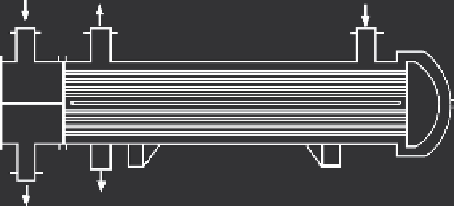Geoscience Reference
In-Depth Information
Cooling
medium
in
Clean gas out
Dirty gas in
Cooling medium; water or air
Condensate out
Cooling
medium
out
FIGURE 16.18
Surface condenser. (From USEPA,
Control Techniques for Gases and Particulates
, U.S.
Environmental Protection Agency, Washington, DC, 1971.)
16.6.1 C
ontaCt
C
ondenser
C
alCulations
In a contact condenser (see Figure 16.17) the coolant and vapor stream are physically mixed. They
leave the condenser as a single exhaust stream. Simplified heat balance calculations are used to
estimate the important parameters. The first step in analyzing any heat transfer process is to set up
a heat balance relationship. For a condensation system, the heat balance can be expressed as
Heat in = Heat out
Heat requiredtoreduce
vaporstothe dewpoint
Heat requiredto
condensevapors
Heat to be removed
by thecoolant
+
=
This heat balance is written in equation form as
q
=
mC
p
(
T
G
1
-
T
dewpoint
) +
mH
v
=
LC
p
(
T
L
2
-
T
L
1
)
(16.21)
where
q
= Heat transfer rate (Btu/hr).
m
= Mass flow rate of vapor (lb/hr).
C
p
= Average specific heat of a gas or liquid (Btu/lb-°F).
T
= Temperature of the streams (subscripts
G
for gas and
L
for liquid coolant).
H
v
= Heat of condensation or vaporization (Btu/lb).
L
= Mass flow rate of liquid coolant (lb/hr).
In Equation 16.21, mass flow rate
m
and inlet temperature
T
G
1
of the vapor stream are set by the
process exhaust stream. The temperature of the coolant entering the condenser (
T
L
1
) is also set. The
average specific heats (
C
p
) of both streams, the heat of condensation (
H
v
),
and the dewpoint tempera-
ture can be obtained from chemistry handbooks. Therefore, only the amount of coolant
L
and its
outlet temperature are left to be determined. If either one of these terms is set by process restrictions
(e.g., only
x
pounds an hour of coolant are available or the outlet temperature), then the other term
can be solved for directly. Equation 16.21 is applicable for direct contact condensers and should be
used only to obtain rough estimates. The equation has a number of limitations:

Search WWH ::

Custom Search